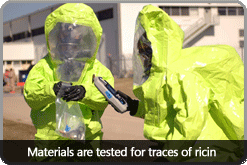There are many animals and insects around the world which use toxins, both for defence and for predation.

Due to the high toxicity of many of the substances detailed on this website, and the fact that many of them are only needed in very small amounts to cause disease, some biotoxins have been exploited in the past as biological warfare agents. Biological warfare is use of biotoxins, such as those we have seen, in war. This means that the aim of the bioweapons is to maim or sometimes kill those that are on the opposing side. As of 1972, the use of bioweapons as a form of attack was made illegal by the BWC (the Biological Weapons Convention), in an attempt to try and protect as many people as possible, as a biological attack could affect whole nations. If a nation, group or individual uses this method of attack, it is considered bioterrorism.
When planning biological warfare, different toxins are chosen for their relative benefits (including incubation time, virulence, infectiousness, availability of vaccines and lethality), depending on the effect desired. According to the Encyclopaedia Britannica, there are five categories of agents which can be weaponised for warfare or terrorism:
 bacteria, such as plague or anthrax.
bacteria, such as plague or anthrax. viruses, such as influenza or encephalitis.
viruses, such as influenza or encephalitis. fungi, such as aflatoxins from Aspergillus species.
fungi, such as aflatoxins from Aspergillus species. rickettsiae, which are microorganisms that are like bacteria but are intracellular parasites, such as typhus.
rickettsiae, which are microorganisms that are like bacteria but are intracellular parasites, such as typhus. other toxins, such as the poisons from animals (e.g. snake or spider venom) and plants (e.g. ricin toxin).
other toxins, such as the poisons from animals (e.g. snake or spider venom) and plants (e.g. ricin toxin).

A biological attack could be used for various reasons. These include to specifically target, and so eliminate crops or vegetation as well as livestock (in a war, this might mean that the opposing army would starve and therefore have less chance of holding out and winning the war). Also, animals and livestock could be attacked for other reasons, such as their use for transport. Finally, it is also possible to use insects to attack – for example, to send infected mosquitoes into an enemy's territory to try and spread disease. This is known as entomological warfare.
At the moment, agents that are seen as potential and the most likely threats for a terrorist attack, or similar, include ricin, anthrax, smallpox and botulinum toxins: all of which are extremely lethal to humans and could cause massive widespread chaos. As stated in an article on bioweapons in BMJ in 2002, bioweapons which are viable and usable are actually technically not hard to produce – a scary prospect when many and most countries lack any legal protection against these weapons.
Currently, since its creation in 2003, a non-government organisation called the BWPP (the BioWeapons Prevention Project) works to try and stop the use and storage of bioweapons, by monitoring governments around the world and advising them on policy. This is an attempt to eliminate bioweapons, and to ensure that any future warfare is fairer and would not necessarily affect the world in a way that it could not come back from.


